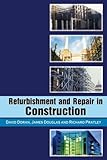| Title: | Refurbishment and Repair in Construction |
| Categories: | Construction |
| ISBN-10(13): | 1439808716 |
| Publisher: | CRC Press |
| Publication date: | 2009-06-15 |
| Edition: | 1 |
| Number of pages: | 480 |
| Language: | English |
| Picture: |

|
| Review: |
With refurbishment and repair accounting for 50% of construction turnover this is a big market. Yet the books and papers that support it are few. Repair and refurbishment would appear to be the Cinderella sector of the construction market. It is therefore refreshing to see the subject tackled so comprehensively in this book. The authors' disciplines are a civil/structural engineer, a quantity surveyor and an architect - bringing together the range of skills that are present in repair and refurbishment. The authors describe repair and refurbishment of buildings as a daunting task, more difficult and more demanding than realised at first sight. The challenge is frequently re-constructing for modern use whilst retaining and matching the original style. The knowledge required is not only of the modern techniques and materials but also knowledge and understanding of the original materials and building techniques. The legal constraints, modern legislation and regulation would have been largely absent during an original construction and now have to be addressed in the refurbishment. The authors emphasise the difficulty of finding the data required on original buildings and quote the standing committee on structural safety who estimate corporate amnesia of 35 years. That is the data available in a corporate organisation has largely disappeared after 35 years So how does the repairer and refurbisher get to grips with such issues as understanding the properties of the materials used, the structural integrity of the building, the reasons for distortion and cracking and the scope for incorporating new floors. This calls for careful diagnosis and a design of remedial work that will not exaggerate the problems. When considered the authors' description of daunting doesn't seem exaggerated. This books provides a framework of the knowledge required and gives many references to essential sources of information. The contents of the book are wide ranging covering in an excellent introduction including reasons for refurbishment, design life, forensics , energy conservation, unnecessary repairs, safety and conservation. The introduction is a section well worth reading when you're standing in the book shop, it will persuade you to buy the book. Section 2 is entirely devoted to risks including a categorisation of risks and interestingly attitudes to risk. Section 3 addresses sources of information and discovering process. Largely concentrating on materials in particular concrete, timber, masonry, metals and plastics. Section 4 reviews the major forms of contract used for repair and refurbishment. Section 5 is the main section of the book being 136 pages long. It is entitled Types of construction: disasters, defects and potential solutions. Covering each of the main materials in turn gives a description of their use. The section also covers other matters such as: environmental conditions; condensation; dampness; thermal insulation; sound insulation; fire engineering; vibration; and a wide range of construction techniques as well as specific issues including flat and pitched roofs, tenements, heritage, bridges, tunnels, asbestos, new services, service loads and underground services. Section 5 contains the core information of this book with the other sections supporting and providing the context. Section 5 is the section that provides the technical knowledge needed in repair and refurbishment. Section 6 provides a review of all the legal restraints including planning; listed building and building legislation. Section 7 presents a wide range of case studies giving examples of where all the knowledge in section 5 can be brought together to provide successful outcomes. This book is essential for any practitioner in repair and refurbishment. I can see engineers going home in the evening with a problem on their mind and turning to this text for guidance, if it doesn't have the solution then it will offer guidance to where the solution might be found. To the student market this book has the capability of inspiring a career in repair and refurbishment but only for the resilient who are not put off by the daunting nature of the task. The authors express their regret that refurbishment and repair does not feature much in formal degree and other training programmes. That regret is well justified and there should be more formal education either in under-graduate or post-graduate programmes supporting this sector of the industry. Ronald McCaffer |



